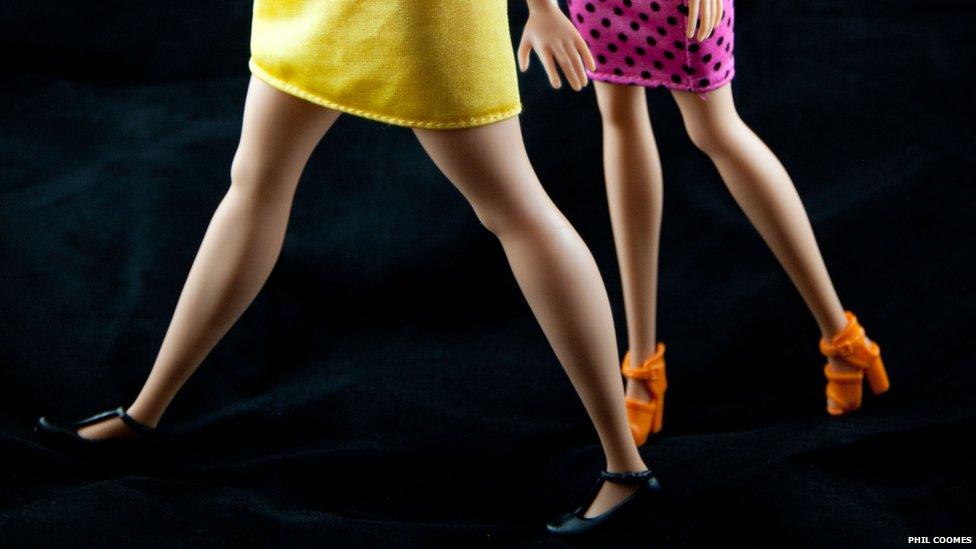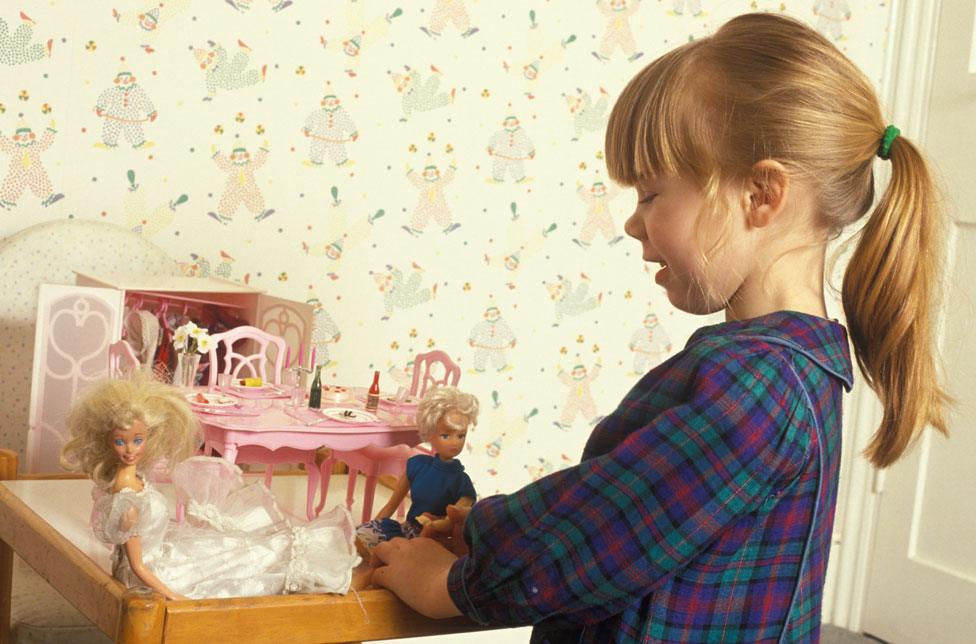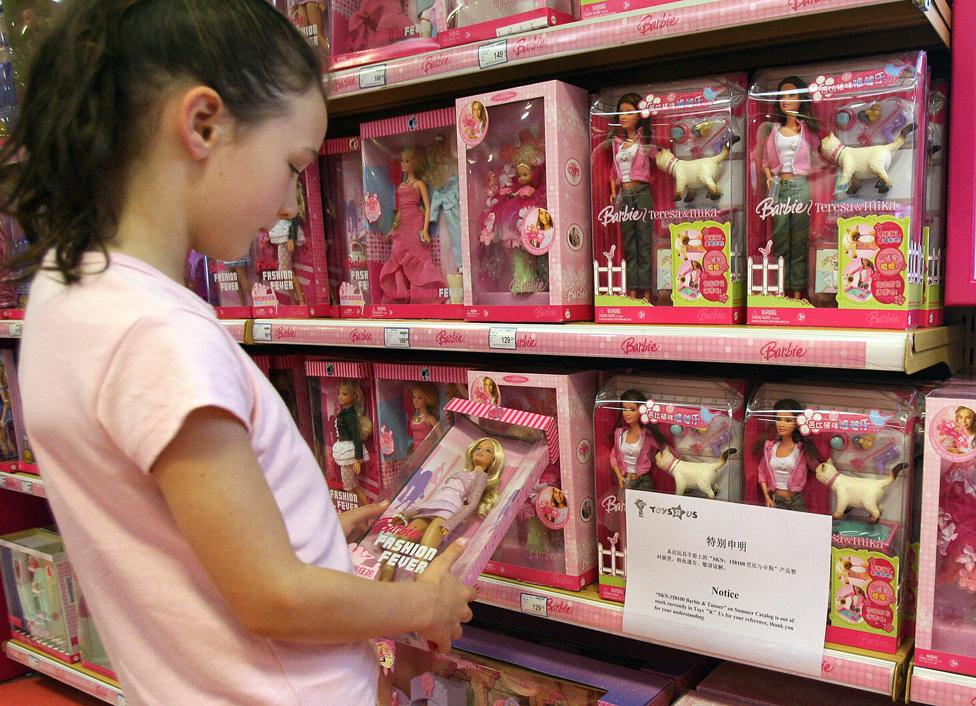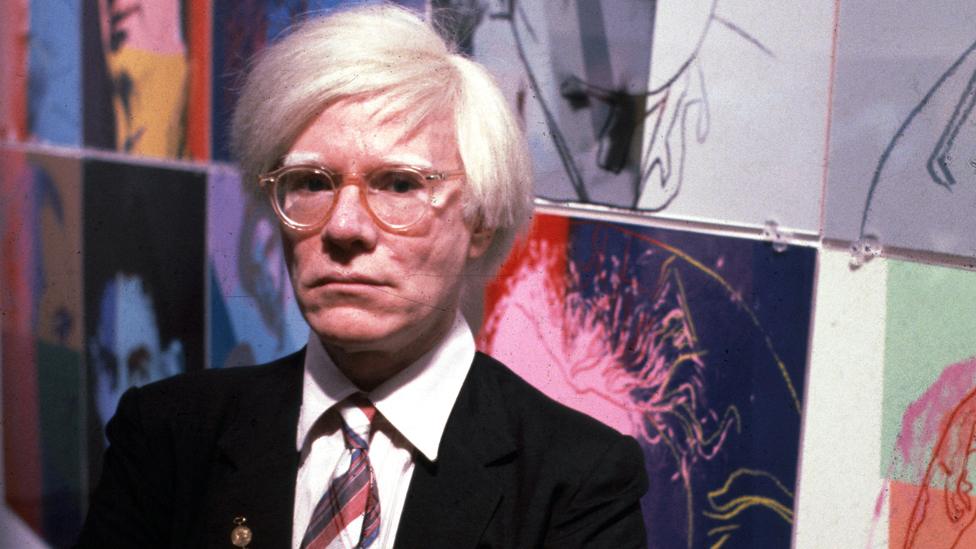How does 'Curvy Barbie' compare with an average woman?
- Published

Mattel has been praised for the release of three new types of Barbie - curvy, petite and tall. They've now gone on sale in the UK but how close do the dolls come to representing the average young woman?
Say the word "Barbie" and you'll probably picture a thin doll with make-up, a mane of straight blonde hair and garish clothes.
Now toymakers Mattel have released three new body shapes. Original Barbie is being joined by Curvy Barbie, Tall Barbie and Petite Barbie. The latest Fashionistas line, external also features a wide range of skin tones reflecting many different ethnicities.
With children's body image firmly on the agenda, the new dolls' arrival has been met by a broadly positive response, external. But how reflective are these dolls of young women in Britain and America?
If Barbie were a real woman...

Mattel says it doesn't have a scale that would give Barbie's full-size dimensions. But there is "playscale" - a ratio of 1:6 that governs the size of many toys. If you accept that as a ratio for Barbie then you can multiply all her dimensions by six to find the real-world size.
Like the first ever Barbie, Curvy Barbie is 11in (27.9cm) tall. Multiply by six and you find Barbie would be 5ft 6in. That's taller than the average UK woman at 5ft 3in and slightly more than the average US woman at just under 5ft 4in, external.
Real-life Barbie has often been credited as being 5ft 9in, but this may come from measuring the doll in its typical high-heeled shoes before scaling up. To simply take Barbie as 5ft 9in would produce a ratio of 6.35 and different measurements.

So what dress size would scaled-up Curvy Barbie be?
You can use the Marks and Spencer's size guide, external to give a sense of which dress size would fit each Barbie. Curvy Barbie's measurements for this exercise were done using thread which was then measured, so there is a small margin for error.
The M&S guidelines include approximate waist and hip measurements. M&S doesn't go below a size 6, but you can estimate the lower sizes by looking at the difference between the larger sizes. A UK dress size is generally two dress sizes larger than its US equivalent, so a UK size 10 would be a US size 6.
The 1:6 calculations reveal that Curvy Barbie would have a UK size 6/8 waist (63cm or 24.8in) and size 8 hips (91.2cm or 35.9in). Her waist-to-height ratio, which is considered by many a more accurate health measurement than Body Mass Index (BMI), is 0.38 - slim indeed.
She is far slimmer than the average 16-24-year-old woman in the UK. The average British woman of this age is 164.5cm (5ft 5in) and has a waist measuring 79.5cm (31.3in), according to the 2012 Health Survey of England, external. Those figures on the M&S scale would equate to a dress size 14.
But Curvy Barbie has been praised by commentators, external as a marked improvement. By the same scaling, if original Barbie were a real woman she would have a size 2 waist (54cm) and size 2 hips (78cm). It's possible to imagine her having difficulty standing upright.

Stepping out: The difference in gait between a Curvy Barbie (left) and an original Barbie
"The introduction of a new range of Barbies is a welcome move, and a positive step towards improving diversity of toys," says Jemima Olchawski, of the Fawcett Society.
But while Curvy Barbie is closer to reality, Tall and Petite Barbie do not fare so well when scaled up to real size. Tall Barbie would be 5ft 11in (180cm) tall, with a size 4 waist (56.4cm) and size 2 hips (78cm). Petite Barbie would be 4ft 11in (158.7cm) tall with a size 2 waist (52.8cm) and size 0 hips (72cm).
However, were Mattel required to accurately reflect the average British and American woman across all ages, the dolls would be overweight or obese.
The average British woman, at 5ft 3in (161.9cm) with a waist of 87.6cm (34.5in), is classed as overweight using the waist-to-height ratio. The average American woman, external, at 5ft 4in (162.1cm) with a waist of 95.3cm (37.5in) is classed as obese.
Mattel argues Barbie shouldn't be expected to represent average proportions in the first place. "Barbie is a doll. She is not meant to reflect a real woman's body," says Sarah Allen from Mattel UK. "The purpose of introducing three new bodies into the range is variety and differentiation. When you look at the dolls collectively you can see the range in relationship between the dolls. "
However, psychologist Helga Dittmar, from Sussex University, says this is missing the point. "To say 'Barbie isn't supposed to be realistic' is side-stepping the issue. If there is evidence that the doll does harm, if intended or not, then that is extremely worrisome."

Dittmar conducted research in 2006, which found that children aged between five-and-a-half and seven-and-a-half years old, were less satisfied with their own body shape after reading a book featuring pictures of the original Barbie. Those who read the same story without the images were not affected.
"The girls said they wanted a thinner body shape than they had. They had lower body-esteems after seeing pictures of Barbie," Dittmar says. "If we show an effect with a single exposure study it stands to reason that the impact increases as time moves on."
But she adds: "It's encouraging that Barbie is now coming in different body shapes, it's a step in the right direction."
Lenore Wright, from Baylor University, Texas, conducted a study in 2003 that explored the role of Barbie. She found Barbie's shape didn't really matter to children - her function was more important.
"Barbie offers children a safe and creative arena for modelling and formulating their own images of what is beautiful."

However, she believes children today may have a changing relationship with their dolls.
"[There has been] an increase in body consciousness, and it's possible this is being projected on to the doll. Mattel focus groups found many of the young girls called the Curvy Barbie 'fat'," she says.
"But I still think for most children the dolls acts as a prop."
Wright adds that Mattel's new line has been criticised by some feminist scholars for reinforcing an old stereotype - that women are defined by their bodies.
All four of the Barbies have a waist measurement that is close to 70% of their hip measurement. Studies have suggested that men find women more attractive, external when they have a 0.7 waist to hip ratio, whatever their weight.
Time and sales will tell if Barbie's latest transition is a success. If it is, it opens up the possibility of further changes in the future.
"It's good at least something has been done," Dittmar says, "but why can't we have a well-proportioned body?"

More from the Magazine

The pop artist Andy Warhol made his name creating images of iconic American names and brands, from Elvis to Jackie Kennedy, Marilyn Monroe to Mickey Mouse - not to mention soup cans, Coke bottles and dollar bills. The last of these works, painted in the year before he died, was a portrait of his muse, a 23-year-old jewellery designer called BillyBoy* - in the form of a Barbie doll.

Additional reporting by McKenzie Marshall and Teniola Ayoola
Subscribe to the BBC News Magazine's email newsletter to get articles sent to your inbox.